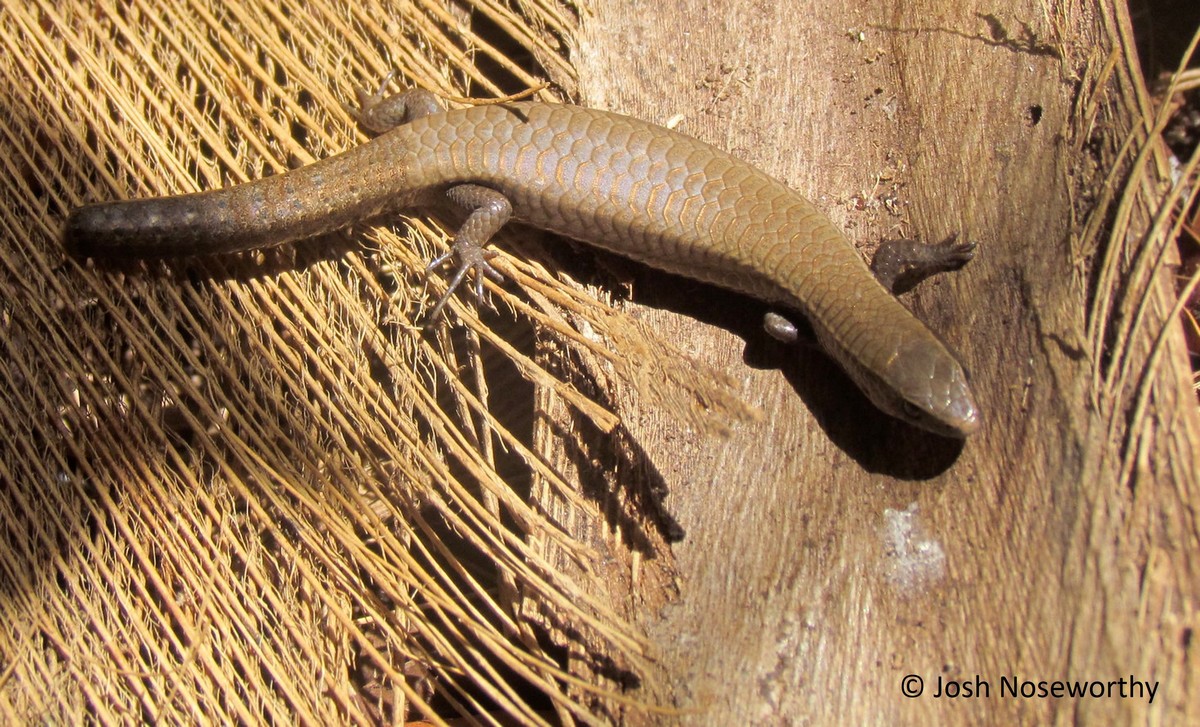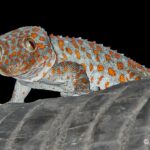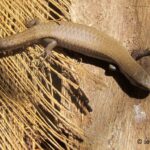
- Nom scientifique : Gymnophthalmus underwoodi (Grant, 1958)
- Nom local: Underwood’s spectacled tegu, Smooth-scaled Tegulet
- Ordre : Gymnophthalmidae
- Famille : Squamata
Description
Morphologie. Lézard de petite taille, au corps et à la queue allongés. La face dorsale est brune, avec une ligne latérale pâle s’étendant depuis le museau jusqu’à la queue, passant au dessus l’œil. Sous cette ligne les écailles prennent une teinte plus foncée. La face ventrale est blanchâtre, avec des taches sombres (Cole et al., 2013; Recoder et al., 2018; van den Burg et al., 2021).
Taille corporelle standard (longueur tête-tronc). jusqu’à 43 mm (Turk et al., 2010; Recoder et al., 2018; van den Burg et al., 2021)
Dimorphisme sexuel. Pas de dimorphisme sexuel (espèce unisexuée) (Cole et al., 1993; Kizirian et Cole, 1999).
Variations.
Confusion possible avec d’autres espèces. La confusion est possible avec une espèce proche d’un point vu phylogénétique, native de Guadeloupe, Dominique, Martinique et Sainte Lucie, Gymnophthalmus pleei. G. underwoodi se distingue par une queue relativement carénée, entrainant un nombre plus faible d’écailles sous la queue (Recoder et al., 2018).
Distribution
Native. Venezuela, Guyana (Cole et al., 2013), Suriname (Jairam, 2016), Guyane, Brésil (de Oliveira et al., 2014; Ribeiro-Junior et Amaral, 2016, 2017; Recoder et al., 2018; Farias and Vogt, 2020).
Caraïbes: Grenade, Saint Vincent et les Grenadines (Daudin et Silva, 2007; Powell et Henderson, 2017; Recoder et al., 2018), Trinidad, Tobago (Auguste, 2019), Barbade (Ribeiro-Junior et Amaral, 2016, 2017).
Introduit. Floride (van den Burg et al., 2021).
Dans les Caraïbes, le statut d’espèce native ou introduite n’est pas clairement établi pour toutes les populations.
Caraïbes: Cuba (Borroto-Páez et al., 2012), République Dominicaine (Szkudlarek, 2019; Reyes et al., 2020), Îles Vierges Américaines et Britanniques, Antigua, Barbuda (Censky et Lindsay, 1997; Daltry, 2011), Saint Martin, Saint Kitts, Nevis, Saba, Montserrat, Saint Barthélemy (Questel et Boggio, 2012; van den Burg et al., 2021), Guadeloupe (Lorvelec et al., 2007; Breuil, 2010), Dominique (Turk et al., 2010), Martinique (Lorvelec et al., 2007; Breuil, 2010).
Biologie et écologie
Habitat. Gymnophthalmus underwoodi évolue dans une grande diversité d’habitats naturels et anthropisés. L’espèce est observée dans les forêts humides et sèches, les bords de rivières, les pentes rocheuses à végétation basse ou encore dans les jardins et zones périurbaines (Ribeiro-Junior et Amaral, 2017; Recoder et al., 2018; van den Burg et al., 2021).
Régime alimentaire. Insectivore (Powell et Henderson, 2017).
Reproduction. G. underwoodi est une espèce parthénogénétique, c’est-à-dire que les femelles pondent des œufs se développant sans la nécessité d’être fécondés (Cole et al., 1993; Kizirian et Cole, 1999).
La reproduction peut avoir lieu tout au long de l’année, et les femelles produisent un à quatre œufs par ponte (Kalaisko, 2015).
Comportement.
Impact et gestion des populations introduites
Impact. L’impact de Gymnophthalmus underwoodi sur les écosystèmes natifs des régions d’introduction reste méconnu.
Gestion. Aucune mesure de contrôle ciblée n’est à ce jour établie dans les différentes régions d’introduction de l’espèce.
Le statut d’espèce native ou introduite n’est pas clairement établi pour plusieurs populations des Caraïbes (Lorvelec et al., 2007).
Bibliographie
- Auguste, R. J. (2019). Herpetofaunal checklist for six pilot protected areas in Trinidad and Tobago. Herpetology Notes, 12, 577–585.
- Breuil, M. (2010). Gymnophthalmus underwoodi (Smooth-scaled Worm Lizard). Distribution. Caribbean Herpetology, 30.
- Censky, E. J., & Lindsay, K. (1997). Gymnophthalmus underwoodi. Herpetological Review, 28, 210.
- Cole, C J, Dessauer, H. C., & Markezich, A. L. (1993). Missing link found: the second ancestor of Gymnophthalmus underwoodi (Squamata: Teiidae), a South American unisexual lizard of hybrid origin. American Museum Novitates, 1–13.
- Cole, Charles J., Townsend, C. R., Reynolds, R. P., MacCulloch, R. D., & Lathrop, A. (2013). Amphibians and reptiles of Guyana, South America: Illustrated keys, annotated species accounts, and a biogeographic synopsis. Proceedings of the Biological Society of Washington, 125, 317–578.
- Daltry, J. C. (2011). An Introduction to the herpetofauna of Antigua, Barbuda and Redonda, with some conservation recommendations. Conservation of Caribbean Island Herpetofaunas, 2, 17–51.
- Daudin, J., & De Silva, M. (2007). An annotated checklist of the amphibians and terrestrial reptiles of the Grenadines with notes on their local natural history and conservation. Applied Herpetology, 4, 163–175.
- de Oliveira, D. P., Souza, S. M., Frazão, L., de Almeida, A. P., & Hrbek, T. (2014). Lizards from central Jatapú River, Amazonas, Brazil. Check List, 10, 46–53.
- Farias, R. E. S., & Vogt, R. C. (2020). Gymnophthalmus underwoodi (Smooth-scaled Worm Lizard). Brazil: Roraima. Herpetological Review, 51, 9430.
- Jairam, R. (2016). Attempted predation on a Smooth-scaled Worm Lizard, Gymnophthalmus underwoodi (Grant 1958) by a Rainbow Whiptail, Cnemidophorus lemniscatus (Linnaeus 1758) in Suriname. IRCF Reptiles and Amphibians, 23, 93–94.
- Kalaisko, V. (2015). Gymnophthalmus underwoodi (Shiny Lizard). The Online Guide to the Animals of Trinidad and Tobago.
- Kizirian, D. A., & Cole, C. J. (1999). Origin of the unisexual lizard Gymnophthalmus underwoodi (Gymnophthalmidae) inferred from mitochondrial DNA nucleotide sequences. Molecular Phylogenetics and Evolution, 11, 394–400.
- Lorvelec, O., Pascal, M., Pavis, C., & Feldmann, P. (2007). Amphibians and reptiles of the French West Indies: Inventory, threats and conservation. Applied Herpetology, 4, 131–161.
- Páez, R. B., Bosch, R. A., Fabres, B. A., & Garcia, O. A. (2012). Introduced amphibans and reptiles in the Cuban Archipelago. Herpetological Conservation and Biology, 10, 985–1012.
- Powell, R., & Henderson, R. W. (2017). Notes on the diets of some amphibians an reptiles if the St. Vincent and Grenada banks (Lesser Antilles). IRCF Reptiles and Amphibians, 24, 135–138.
- Questel, K., & Boggio, J. (2012). Gymnophthalmus underwoodi (Smooth-scaled Worm Lizard). Distribution. Caribbean Herpetology, 36.
- Recoder, R. S., Dal Vechio, F., Marques-Souza, S., Teixeira, M., Silva-Da-Silva, M., Santos, A. P., … Rodrigues, M. T. (2018). Geographic variation and taxonomy of red-tailed Gymnophthalmus (Squamata: Gymnophthalmidae) from Amazonian Savannas. Zootaxa, 4497, 61–81.
- Reyes, F. O., Landestoy, M. A., Jiménez, L., & Bobadilla, M. R. (2020). Gymnophthalmus underwoodi (Underwood’s Spectacled Tegu). Dominican Republic: Santo Domingo. Herpetological Review, 51, 539–540.
- Ribeiro-Júnior, M. A., & Amaral, S. (2017). Catalogue of distribution of lizards (Reptilia: Squamata) from the Brazilian Amazonia. IV. Alopoglossidae, Gymnophthalmidae. Zootaxa, 4269, 151–196.
- Ribeiro-Júnior, M., & Amaral, S. (2016). Diversity, distribution, and conservation of lizards (Reptilia: Squamata) in the Brazilian Amazonia. Neotropical Biodiversity, 2, 195–421.
- Szkudlarek, M. (2019). Gymnophthalmus underwoodi (Underwood’s Spectacled Tegu). Dominican Republic: La Alta Gracia Province. Herpetological Review, 50, 524–525.
- Turk, P. A., Wyszynski, N. N., Powell, R., & Henderson, R. W. (2010). Population densities and water-loss rates of Gymnophthalmus pleii, Gymnophthalmus underwoodi (Gymnophthalmidae), and Sphaerodactylus fantasticus fuga (Sphaerodactylidae) on Dominica, West Indies. Salamandra, 46, 125–130.
- van den Burg, M. P., Hylkema, A., & Debrot, A. O. (2021). Establishment of two nonnative parthenogenetic reptiles on Saba, Dutch Caribbean: Gymnophthalmus underwoodi and Indotyphlops braminus. Caribbean Herpetology, 79, 1–5.





